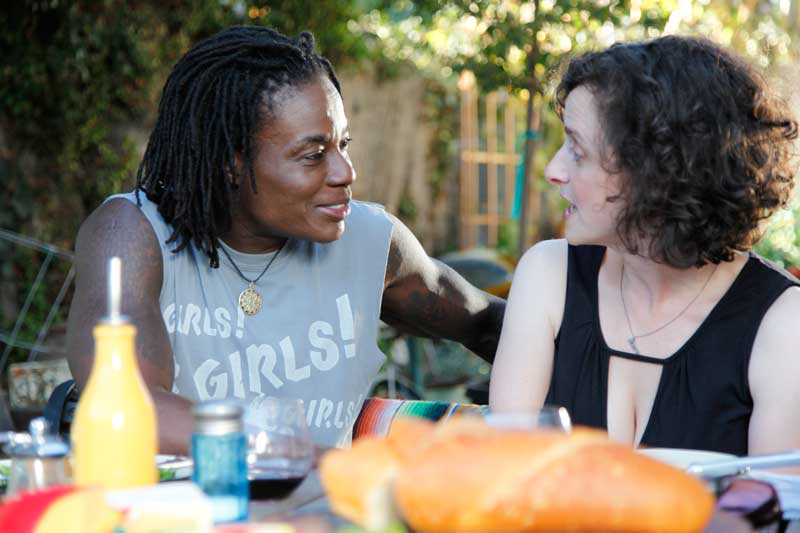|
The Paliament Film Collective's (Partial) Canon of Lesbian Cinema |
||||
 |
||||
Skye and Lily (Skyler Cooper and Lisa Gornick). Still from The Owls (dir. Cheryl Dunye, 2010). Used with permission from the Parliament Film Collective. |
||||
The Parliament Film Collective's
(Partial) Canon of Lesbian Cinema
(The following lists and discussions about lesbian cinema are in no way meant to be comprehensive but are rather demonstrative of the way that conversation and collective naming create new kinds of knowing.)
The Owls was made by a Parliament of approximately sixty real-life OWLs (Older Wiser Lesbians), as well as younger women, and a small number of queer men. Many in our collective cut our filmmaking teeth during the glory days of New Queer Cinema. Thus, the films we have made are the first to be included in our partial canon: The Watermelon Woman (Cheryl Dunye, 1995), Go Fish (Rose Troche, 1994), Tick Tock Lullaby (Lisa Gornick, 2007), B.D. Women (Inge Blackman, 2008), Hooters (Anna Margarita Albelo, 2010), Swimming (P. David Ebersole and Todd Hughes, 2010), and 2 Tickets to the Movies (Michael Lucid, 2010). To make The Owls, many of us returned, older and sometimes wiser, to the possibilities of collective/lesbian creative processes, queer community, and microbudget cinema. In the process, we tried to learn from and rethink the formal strategies of lesbian cinema, particularly because we were making a feature film for almost no money. So we also looked to even earlier patriarchal images of lesbian dysfunction (The Killing of Sister George [Robert Aldrich, 1968], The Fox [Mark Rydell, 1967], The Children’s Hour [William Wyler, 1961]), as well as to the films of the New Queer Cinema of gay men: the works of Todd Haynes, Tom Kalin, and Greg Araki, not to mention David Lynch (in regards to using genre and maintaining an avant-garde sensibility).
Behind our working in a collective is the hope and principle that we would learn from each other. Production assistant extraordinaire Tania Hammidi writes:
I came to The Owls because of the collective and historical orientation of the film and because of Candi Guterres’s reputation for great set design and work ethic. I came to learn from the best. I was greatly influenced by Cheryl Dunye's fictional film Stranger Inside (2000). The strength of the storyline matched the difficulty of the topic, African American women in prison. I wanted to run alongside Director Dunye, to hear, watch, and learn from a talented cinematic mind at work.
It is critical to note that unlike a more typical apprenticeship, the members of our collective were seeking a very particular type of learning: about the complex integration of story and style, individual and community. In the question-and-answer session after the screening of the film at the Berlinale, Dunye remarks that The Owls is about “breaking and reinventing film form, pushing storytelling.” It is a given in the collective that our complex, multifaceted stories of situated sexualities demand formal invention (in style and method).
Campbell, who worked as our “sound man,” continues in this vein:
Isaac Julien's Looking for Langston (1988) and Derek Jarman's Wittgenstein (1993) influenced my work. Those two works showed me that one could be imaginative with set design and storytelling style. B.D. Women (1994) was a film that shows some influences from these two films, but has a more womanist approach. Looking for Langston made me realize that there was a way to have a “Black queer” aesthetic—to tell queer stories from a non-Eurocentric perspective. In addition, both films are about queer politics, and they also are very beautiful and show the queer gaze and queer desire without censure. I strive to have visual pleasure in my work and to create an active lesbian gaze.
Similarly, an emphasis on learning from multifarious queer stylistics—beautiful and subtle enough to hold the range, complexity, and pleasures of our experiences—brought Michael Lucid to play the role of the gay realtor for the collective:
My comedic performance in The Owls was inspired by the comedic performances of the sketch TV series Kids in the Hall (1988-94), which has a very gay sensibility (and at least one out gay actor/writer). I’m also influenced by the genre-blending, comedic/melancholy films of Todd Haynes. These influences have helped shape my own performance and writing style, which combines comedic and melancholy elements with a sensibility that is both camp and cerebral.
Copyright © 2014. All rights reserved.